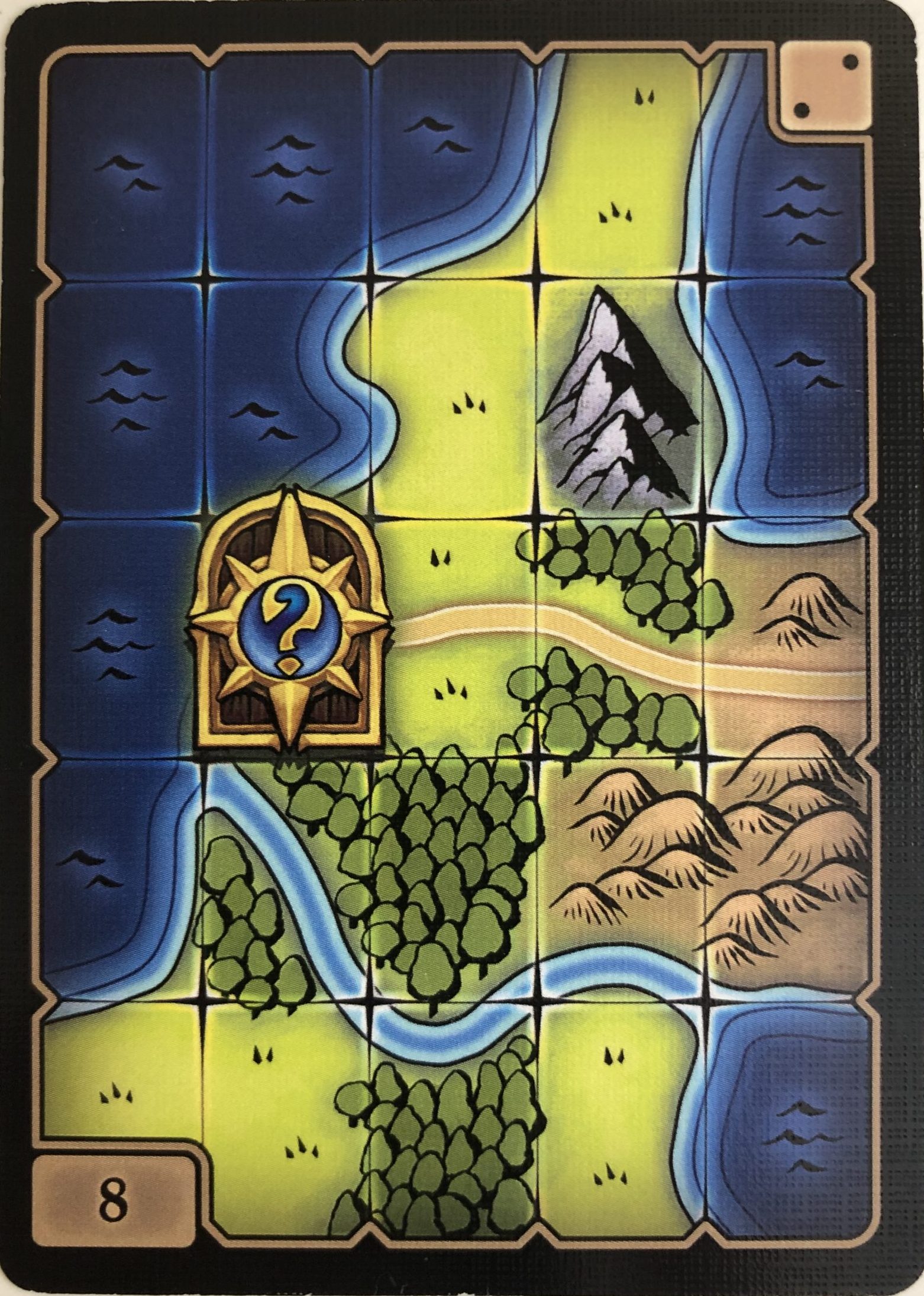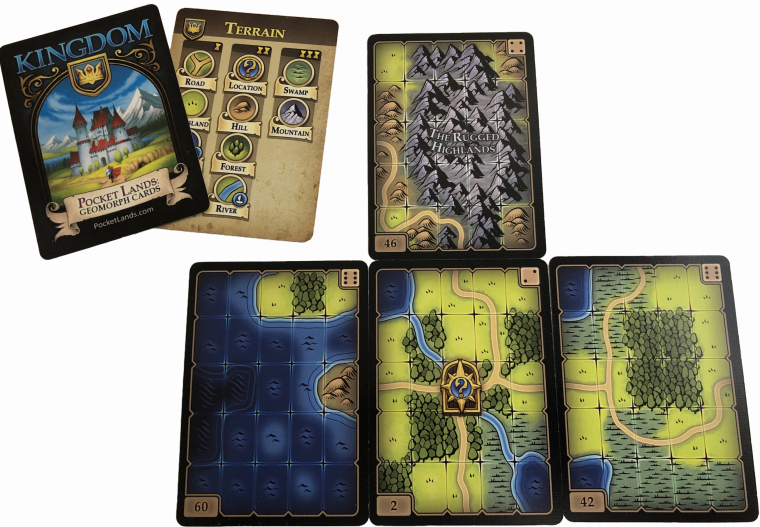Pocket Lands Geomorph Cards, by Alexey Aparin, are decks of illustrated map tiles for tabletop role-playing games. I like them for solo play because they make it fast and easy to create a map without having to draw it myself. They can be used with any RPG system, and you can also use them as inspiration for drawing your own maps. These cards are flexible enough to work with any game that needs a overland map.
Each card is a five-by-five grid of map squares showing different terrain features such as locations, roads, rivers, grassland, forest, hills, mountains, swamp, shallow water, and deep ocean.

On one side of the card is the illustrated map. On the other side is the name of the card’s primary terrain type, for example “Hills” if most of the terrain is hills. This can be used in play to represent what characters generally know about a region without revealing the full details. The cards are arranged during play to form an overland map. You can start with a small group of cards and expand the map over time. Even with just the first set, the Kingdom card set, you can make a large map. With all the sets combined, the potential map size is huge—more than most tables can fit.
There are five card sets in total: Kingdom, High Seas, Deserts, Frostlands, and Marshes. The Kingdom set is the recommended starting point. It contains 68 map cards, one ration tracker card, and a terrain card listing terrain types and movement costs. The terrain in this set covers standard medieval fantasy landscapes such as grasslands, forests, hills, mountains, rivers, and roads. Rules for travel, exploration, and encounters can be downloaded for free from the Pocket Lands website. The High Seas set is best for ocean-based adventures. It contains 68 map cards, a terrain card, and a Wind Rose card that lets you roll for wind direction, which is important for sailing ships. The Deserts, Marshes, and Frostlands sets add more terrain variety. Each of these expansion sets has 30 map cards, a terrain card, and a feature card that adds a game mechanic. The Desert set includes a water ration card for tracking water supply. The Marshes set includes a weather card for rolling random weather conditions. The Frostlands set includes a light tracker card for keeping track of light sources such as torches, candles, campfires, and lanterns.
The cards are well drawn, colorful, and printed on good-quality stock with a matte finish. They are sturdy enough to last through regular use. The terrain artwork is clear and easy to read, making it simple to see where roads, rivers, or coasts connect. The poker-size format makes them easy to handle and arrange on a table.
The downloadable rules include systems for overland travel, exploration, and encounters. Player characters move in four directions over land—north, east, south, and west—while ships on the ocean can move in eight directions. A party has three movement points per day, and each terrain type has a movement cost. For example, moving over grasslands costs one point, while moving through mountains costs three. After movement points are spent, the party must rest for the night. On average, it takes one to four days to cross a single card. The default rules suggest rolling for an encounter for each square the party moves through. I found that too frequent, so I use a house rule with a 50/50 chance of an encounter instead.
If you want to reveal new terrain randomly while exploring, you only need a six-sided die. For example, if the party is at the northern edge of a map card and the five squares along that edge are grasslands, grasslands, forest, hills, and grasslands, you can assign each square a number (grasslands=1, grasslands=2, forest=3, hills=4, grasslands=5) from one to five and roll the die. If you rolled a three, for example, you would place a forest card to the north. If you roll a six, place a random terrain card instead.
A quick way to create a compact map for a session is to use a nine-pocket trading card page, the kind with transparent three-by-three card sleeves, and slide nine map cards into it. This keeps the map organized, easy to store away, and you can even draw on it (the sleeves) with erasable marker.
Pocket Lands Geomorph Cards are a solid tool for anyone who enjoys tabletop role-playing games, especially solo players who want to keep things simple and flexible. They take away the burden of having to draw detailed maps while still giving you a strong sense of exploration and variety. Whether you use them as a full mapping system, a supplement to another game, or just as inspiration for your own designs, the cards offer a lot of value. Even with only the Kingdom set, you can create plenty of adventures, and the other sets expand the possibilities even further. If you are looking for a practical and creative way to handle overland maps, these cards are worth picking up. They can be found at Drive Thru RPG.

